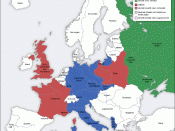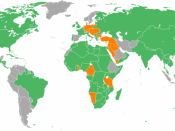Comparing and contrasting the two world wars�� PAGE \* MERGEFORMAT �8��� Comparing and contrasting the two world wars�� PAGE \* MERGEFORMAT �1���
CHC2D1
Grade 10 Canadian History
Comparing and Contrasting the Two World Wars
By: David Vigdorovitch
For: Mr. Hubbard
Date Submitted: May 9th, 2012.
World War I, also known as The Great War, was supposed to end all disputes between conflicting countries in Europe. The Treaty of Versailles was signed June 28th, 1919 in order to reinstall peace and suppress any additional quarrelling between Germany and the Allied Powers. This harsh treaty, which disfavoured the Germans, accomplished the exact opposite because in about twenty years a Second World War broke out. However, in those two decades of ceased fire most nations expanded their knowledge of aviation and land warfare, then implemented this new technology with mass-production, which did not only revolutionize the next war, but would also greatly strengthen the economy of countries such as Canada.
The new technology developed by World War 2 made killing the enemy much tougher in some aspects of battle. This is partially the reason why there were more battles and more troops fighting on European soil in the Second World War. Pre World War Two Canada's army consisted of "4500 troops, 29 Bren guns, 23 anti-tank guns, 5 mortars, 16 tanks and no artillery"(Bain et al.169). However by the end of the war, ground forces augmented to around 708,500 men�, 1,743,000 arms, 815,000 military vehicles, 50,000 tanks, and over 2 million tonnes of explosives�. In contrast, a total of 619,636 Canadians served in World War One (only 424,589 of which fought overseas�).
The style of warfare between the two world wars showed the adjustments that had been made in the use of technology... The Germans introduced the submarine to naval warfare, terrorizing...


